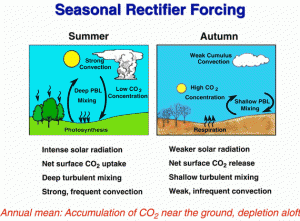Atmosphere
Covariance between atmospheric transport and surface CO2 exchnage produces spatial gradients in the time-mean CO2 concentration field that can be misinterpreted by inverse models of the carbon cycle. These covariance effects have been dubbed “rectifier effects” by analogy to “rectifiers” in electronic circuits.
Because photosynthesis, PBL turbulence, and atmospheric convection over land are all forced by solar radiation at the surface, they are strongly correlated in nature, with strong ventilation and deeper mixing of CO2-depleted air during the day and the growing season, and systematic retention of CO2-enriched air under the nocturnal inversion and during the transition seasons (Fig. 1). By including these effects in a full atmospheric GCM coupled to a new version of the Simple Biosphere Model (SiB2) which predicts CO2 fluxes at the land surface (Sellers et al., 1996a,b; Randall et al., 1996; Berry et al., 1996; Denning et al., 1996a; see section 3.1), we found that the covariance between terrestrial photosynthesis, PBL structure, and cumulus convection produces a “rectifier effect,” which results in a vertical gradient of several parts per million (ppm) in the annual mean CO2 concentration over land (Denning, 1994; Denning et al., 1995, 1996b). This effect is strongest over the temperate and boreal latitudes of the northern hemisphere where vegetation and PBL turbulence are most strongly correlated on seasonal time scales and where the land area is greatest, and therefore produces a north-south gradient in annual mean CO2 concentration at the locations of the observing stations (Conway et al., 1994). This purely natural meridional gradient is half as strong as that produced by the combustion of fossil fuels, and amounts to an “excess” of several ppm of CO2 at high northern latitudes that is not observed. If the rectifier effect is realistic, a net sink of more than 3 Gt C yr-1 is required in temperate and boreal ecosystems for consistency with the flask observations, which is nearly double the “consensus” estimate of the terrestrial sink (IPCC, 1995).
•A summary presentation about these effects in atmospheric and inverse models
• Download an article by Denning et al (1995) on this effect that appeared in Nature
• A longer set of articles by Denning et al (1996) which appeared in Tellus. Part a. Part b.


